一、什么是缓存
缓存就是数据交换的缓冲区Cache,是存储数据的临时地方,一般读写性能较高。
缓存的作用:
- 降低后端负载;
- 提高读写效率,降低响应时间。
缓存的成本:
- 数据的一致性成本;
- 代码维护成本;
- 运维成本。
二、添加Redis缓存

三、缓存更新策略
缓存更新是redis为了节约内存而设计出来的一个东西,主要是因为内存数据宝贵,当我们向redis插入太多数据,此时就可能会导致缓存中的数据过多,所以redis会对部分数据进行更新,或者把他叫为淘汰更合适。
**内存淘汰:**redis自动进行,当redis内存达到咱们设定的max-memery的时候,会自动触发淘汰机制,淘汰掉一些不重要的数据(可以自己设置策略方式)
**超时剔除:**当我们给redis设置了过期时间ttl之后,redis会将超时的数据进行删除,方便咱们继续使用缓存
**主动更新:**我们可以手动调用方法把缓存删掉,通常用于解决缓存和数据库不一致问题

业务场景:
- 低一致性需求:使用内存淘汰机制。例如,店铺类型的查询缓存
- 高一致性需求:主动更新,并以超时剔除作为兜底方案。例如,店铺详情的查询缓存
主动更新策略
- Cache Aside Pattern:由内存的调用者,在更新数据库的同时更新缓存
- 删除缓存还是更新缓存?更新缓存:每次更新数据库都更新缓存,无效写操作较多;删除缓存:更新数据库时让缓存失效,查询时再更新缓存。
- 如何保证缓存与数据库的操作同时成功或失败?单体系统:将缓存与数据库的操作放在一个事务;分布式系统:使用TCC等分布式事务方案。
- 先操作缓存还是先操作数据库?先删缓存,再操作数据库;先操作数据库,再删缓存。
- ReadWrite Through Pattern:缓存与数据库整合为一个服务,由服务来维护一致性。调用者调用该服务,无需关心缓存一致性问题。
- Write Behind Caching Pattern:调用者只操作缓存,由其它线程异步地将缓存数据持久化到数据库,保证最终一致。
四、缓存穿透
缓存穿透是指客户端请求的数据在缓存中和数据库中都不存在,这样缓存永远都不会生效,这些请求都会打到数据库。
常见的解决方案有两种:
- 缓存空对象:
- 优点:实现简单,维护方便;
- 缺点:额外的内存消耗(设置TTL),可能造成短期的不一致
- 布隆过滤:
- 优点:内存占用较少,没有多余key
- 缺点:实现复杂,存在误判可能
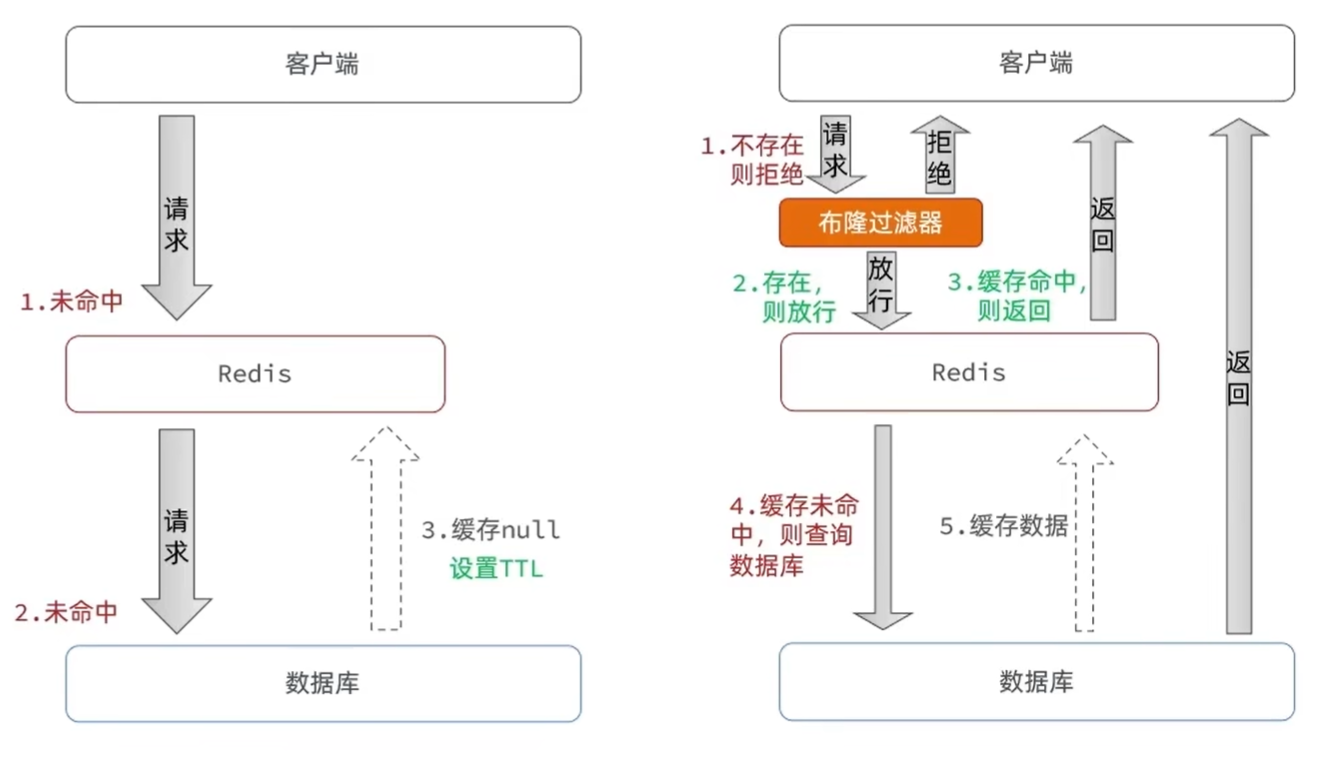
public Shop queryWithPassThrough(Long id){
String key = CACHE_SHOP_KEY + id;
// 1. 从redis查询商铺缓存
String shopJson = stringRedisTemplate.opsForValue().get(key);
// 2. 判断是否存在
if (StrUtil.isNotBlank(shopJson)){
// 3. 存在,直接返回
Shop shop = JSONUtil.toBean(shopJson, Shop.class);
return shop;
}
// 判断命中的是否是空值
if (shopJson != null){
return null;
}
// 4. 不存在,根据id查询数据库
Shop shop = getById(id);
// 5. 不存在,返回错误
if (shop == null){
// 将空值写入redis
stringRedisTemplate.opsForValue().set(key, "", CACHE_NULL_TTL, TimeUnit.MINUTES);
// 返回错误
return null;
}
// 6. 存在,写入redis
stringRedisTemplate.opsForValue().set(key, JSONUtil.toJsonStr(shop), CACHE_SHOP_TTL, TimeUnit.MINUTES);
// 7. 返回
return shop;
}
五、缓存雪崩
缓存雪崩是指在同一时段大量的缓存key同时失效或者Redis服务宕机,导致大量请求到达数据库,带来巨大压力。
解决方案:
- 给不同的Key的TTL添加随机值;
- 利用Redis集群提高服务的可用性;
- 给缓存业务添加降级限流策略;
- 给业务添加多级缓存。
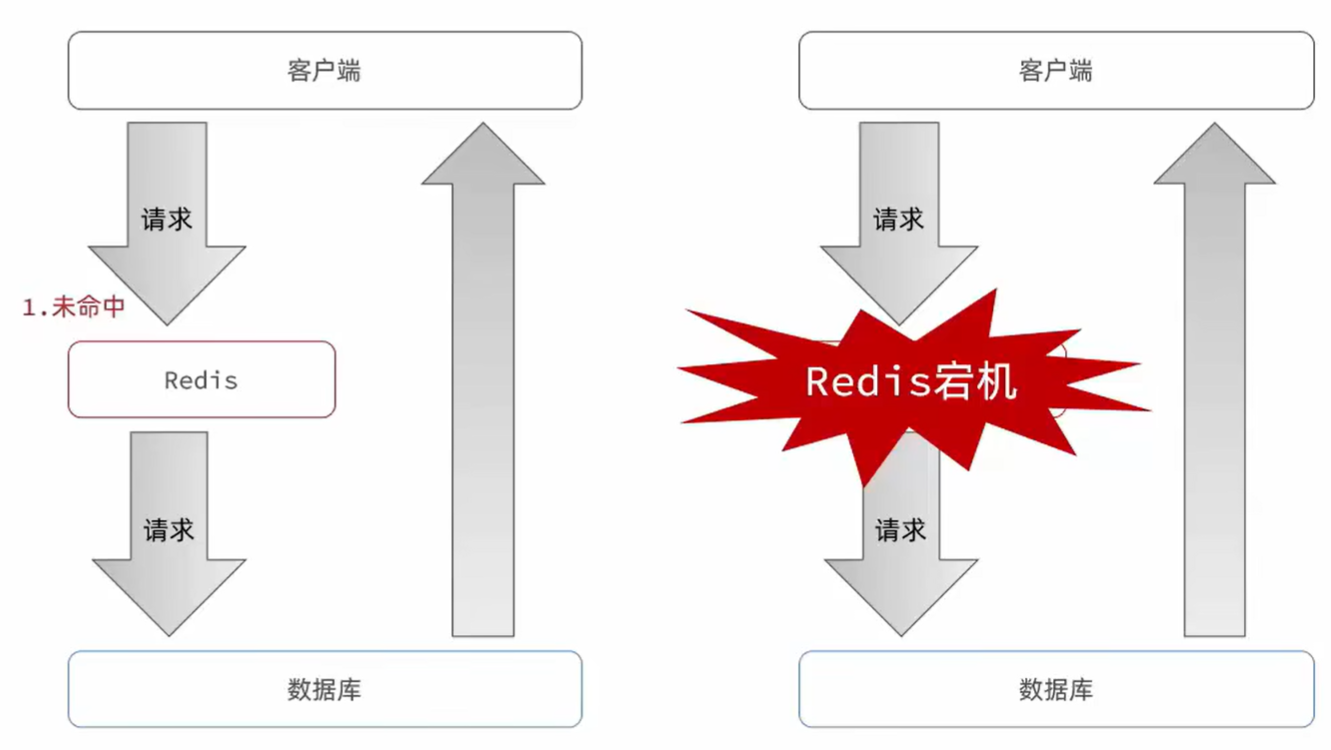
六、缓存击穿
缓存击穿问题也叫热点Key问题,就是一个被高并发访问并且缓存重建业务较复杂的key突然失效了,无数的请求访问会在瞬间给数据库带来巨大的冲击。
常见的解决方案有两种:
- 互斥锁
- 优点:没有额外内存消耗;保证一致性;实现简单。
- 缺点:线程需要等待,性能受影响;可能有死锁风险。
- 逻辑过期
- 优点:线程无需等待,性能较好。
- 缺点:不保证一致性,有额外内存消耗,实现复杂。
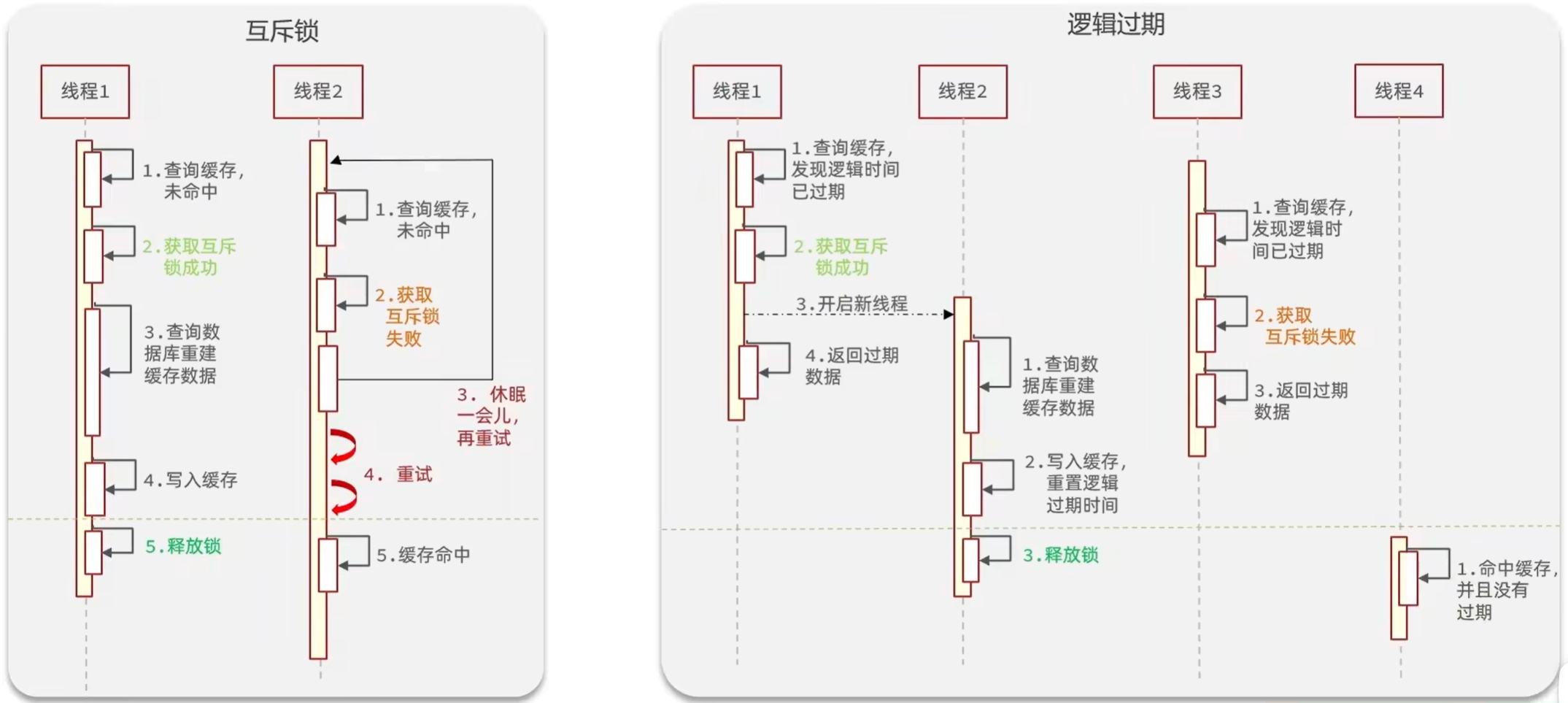
利用互斥锁解决缓存击穿问题
核心思路:相较于原来从缓存中查询不到数据后直接查询数据库而言,现在的方案是 进行查询之后,如果从缓存没有查询到数据,则进行互斥锁的获取,获取互斥锁后,判断是否获得到了锁,如果没有获得到,则休眠,过一会再进行尝试,直到获取到锁为止,才能进行查询。
如果获取到了锁的线程,再去进行查询,查询后将数据写入redis,再释放锁,返回数据,利用互斥锁就能保证只有一个线程去执行操作数据库的逻辑,防止缓存击穿。
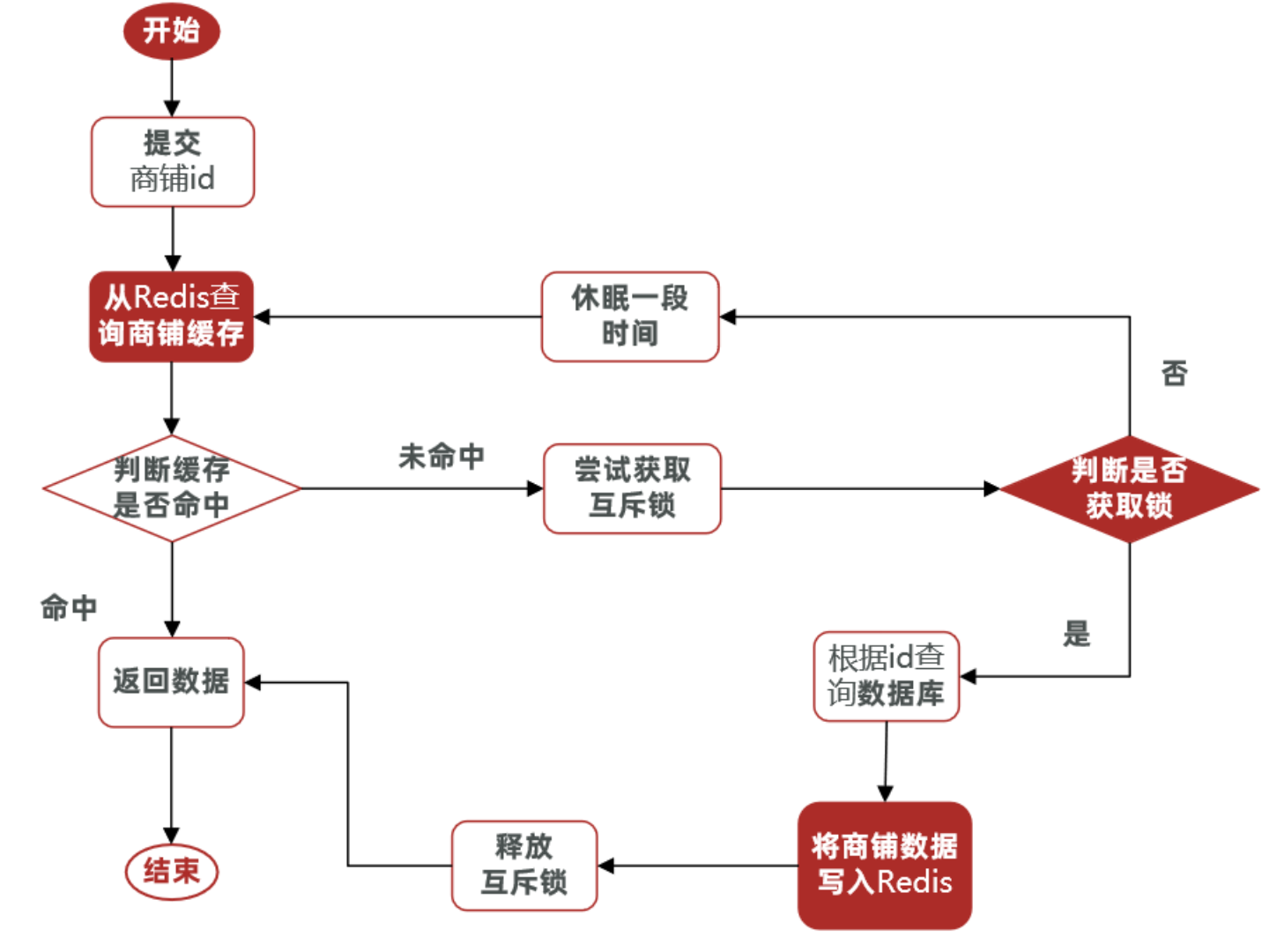
private boolean tryLock(String key){
Boolean flag = stringRedisTemplate.opsForValue().setIfAbsent(key, "1", 10, TimeUnit.SECONDS);
return BooleanUtil.isTrue(flag);
}
private void unLock(String key){
stringRedisTemplate.delete(key);
}
public Shop queryWithMutex(Long id){
String key = CACHE_SHOP_KEY + id;
// 1. 从redis查询商铺缓存
String shopJson = stringRedisTemplate.opsForValue().get(key);
// 2. 判断是否存在
if (StrUtil.isNotBlank(shopJson)){
// 3. 存在,直接返回
Shop shop = JSONUtil.toBean(shopJson, Shop.class);
return shop;
}
// 判断命中的是否是空值
if (shopJson != null){
return null;
}
// 4. 实现缓存重建
// 4.1. 获取互斥锁
String lockKey = LOCK_SHOP_KEY + id;
Shop shop = null;
try {
boolean isLock = tryLock(lockKey);
// 4.2. 判断是否获取成功
if (!isLock){
// 4.3 如果失败,获取锁失败,则休眠并重试
Thread.sleep(50);
return queryWithMutex(id);
}
// 4.4. 获取锁成功,根据id查询数据库
shop = getById(id);
// 模拟重建的延时
Thread.sleep(200);
// 5. 不存在,返回错误
if (shop == null){
// 将空值写入redis
stringRedisTemplate.opsForValue().set(key, "", CACHE_NULL_TTL, TimeUnit.MINUTES);
// 返回错误
return null;
}
// 6. 存在,写入redis
stringRedisTemplate.opsForValue().set(key, JSONUtil.toJsonStr(shop), CACHE_SHOP_TTL, TimeUnit.MINUTES);
} catch (InterruptedException e) {
throw new RuntimeException(e);
} finally {
// 释放互斥锁
unLock(lockKey);
}
// 7. 返回
return shop;
}
利用逻辑过期解决缓存击穿问题
需求:修改根据id查询商铺的业务,基于逻辑过期方式来解决缓存击穿问题
思路分析:当用户开始查询redis时,判断是否命中,如果没有命中则直接返回空数据,不查询数据库,而一旦命中后,将value取出,判断value中的过期时间是否满足,如果没有过期,则直接返回redis中的数据,如果过期,则在开启独立线程后直接返回之前的数据,独立线程去重构数据,重构完成后释放互斥锁。
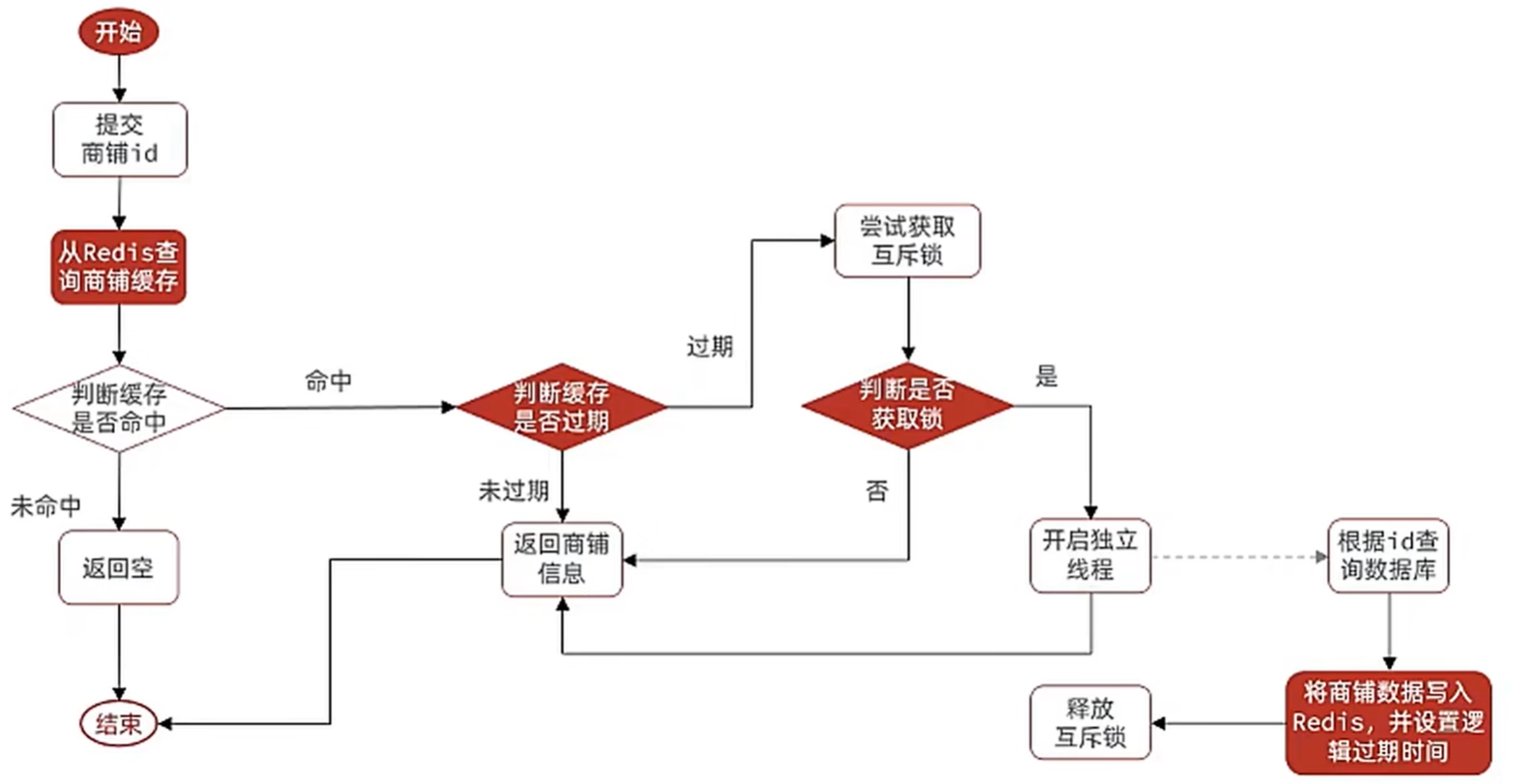
private static final ExecutorService CACHE_REBUILD_EXECUTOR = Executors.newFixedThreadPool(10);
public Shop queryWithLogicalExpire( Long id ) {
String key = CACHE_SHOP_KEY + id;
// 1.从redis查询商铺缓存
String json = stringRedisTemplate.opsForValue().get(key);
// 2.判断是否存在
if (StrUtil.isBlank(json)) {
// 3.存在,直接返回
return null;
}
// 4.命中,需要先把json反序列化为对象
RedisData redisData = JSONUtil.toBean(json, RedisData.class);
Shop shop = JSONUtil.toBean((JSONObject) redisData.getData(), Shop.class);
LocalDateTime expireTime = redisData.getExpireTime();
// 5.判断是否过期
if(expireTime.isAfter(LocalDateTime.now())) {
// 5.1.未过期,直接返回店铺信息
return shop;
}
// 5.2.已过期,需要缓存重建
// 6.缓存重建
// 6.1.获取互斥锁
String lockKey = LOCK_SHOP_KEY + id;
boolean isLock = tryLock(lockKey);
// 6.2.判断是否获取锁成功
if (isLock){
CACHE_REBUILD_EXECUTOR.submit( ()->{
try{
//重建缓存
this.saveShop2Redis(id,20L);
}catch (Exception e){
throw new RuntimeException(e);
}finally {
unlock(lockKey);
}
});
}
// 6.4.返回过期的商铺信息
return shop;
}
七、缓存工具封装
基于StringRedisTemplate封装一个缓存工具类,满足下列需求:
- 方法1:将任意Java对象序列化为json并存储在string类型的key中,并且可以设置TTL过期时间
- 方法2:将任意Java对象序列化为json并存储在string类型的key中,并且可以设置逻辑过期时间,用于处理缓
存击穿问题
- 方法3:根据指定的key查询缓存,并反序列化为指定类型,利用缓存空值的方式解决缓存穿透问题
- 方法4:根据指定的key查询缓存,并反序列化为指定类型,需要利用逻辑过期解决缓存击穿问题
将逻辑进行封装
@Data
public class RedisData {
private LocalDateTime expireTime;
private Object data;
}
@Slf4j
@Component
public class CacheClient {
private final StringRedisTemplate stringRedisTemplate;
private static final ExecutorService CACHE_REBUILD_EXECUTOR = Executors.newFixedThreadPool(10);
public CacheClient(StringRedisTemplate stringRedisTemplate) {
this.stringRedisTemplate = stringRedisTemplate;
}
public void set(String key, Object value, Long time, TimeUnit unit) {
stringRedisTemplate.opsForValue().set(key, JSONUtil.toJsonStr(value), time, unit);
}
public void setWithLogicalExpire(String key, Object value, Long time, TimeUnit unit) {
// 设置逻辑过期
RedisData redisData = new RedisData();
redisData.setData(value);
redisData.setExpireTime(LocalDateTime.now().plusSeconds(unit.toSeconds(time)));
// 写入Redis
stringRedisTemplate.opsForValue().set(key, JSONUtil.toJsonStr(redisData));
}
public <R,ID> R queryWithPassThrough(
String keyPrefix, ID id, Class<R> type, Function<ID, R> dbFallback, Long time, TimeUnit unit){
String key = keyPrefix + id;
// 1.从redis查询商铺缓存
String json = stringRedisTemplate.opsForValue().get(key);
// 2.判断是否存在
if (StrUtil.isNotBlank(json)) {
// 3.存在,直接返回
return JSONUtil.toBean(json, type);
}
// 判断命中的是否是空值
if (json != null) {
// 返回一个错误信息
return null;
}
// 4.不存在,根据id查询数据库
R r = dbFallback.apply(id);
// 5.不存在,返回错误
if (r == null) {
// 将空值写入redis
stringRedisTemplate.opsForValue().set(key, "", CACHE_NULL_TTL, TimeUnit.MINUTES);
// 返回错误信息
return null;
}
// 6.存在,写入redis
this.set(key, r, time, unit);
return r;
}
public <R, ID> R queryWithLogicalExpire(
String keyPrefix, ID id, Class<R> type, Function<ID, R> dbFallback, Long time, TimeUnit unit) {
String key = keyPrefix + id;
// 1.从redis查询商铺缓存
String json = stringRedisTemplate.opsForValue().get(key);
// 2.判断是否存在
if (StrUtil.isBlank(json)) {
// 3.存在,直接返回
return null;
}
// 4.命中,需要先把json反序列化为对象
RedisData redisData = JSONUtil.toBean(json, RedisData.class);
R r = JSONUtil.toBean((JSONObject) redisData.getData(), type);
LocalDateTime expireTime = redisData.getExpireTime();
// 5.判断是否过期
if(expireTime.isAfter(LocalDateTime.now())) {
// 5.1.未过期,直接返回店铺信息
return r;
}
// 5.2.已过期,需要缓存重建
// 6.缓存重建
// 6.1.获取互斥锁
String lockKey = LOCK_SHOP_KEY + id;
boolean isLock = tryLock(lockKey);
// 6.2.判断是否获取锁成功
if (isLock){
// 6.3.成功,开启独立线程,实现缓存重建
CACHE_REBUILD_EXECUTOR.submit(() -> {
try {
// 查询数据库
R newR = dbFallback.apply(id);
// 重建缓存
this.setWithLogicalExpire(key, newR, time, unit);
} catch (Exception e) {
throw new RuntimeException(e);
}finally {
// 释放锁
unlock(lockKey);
}
});
}
// 6.4.返回过期的商铺信息
return r;
}
public <R, ID> R queryWithMutex(
String keyPrefix, ID id, Class<R> type, Function<ID, R> dbFallback, Long time, TimeUnit unit) {
String key = keyPrefix + id;
// 1.从redis查询商铺缓存
String shopJson = stringRedisTemplate.opsForValue().get(key);
// 2.判断是否存在
if (StrUtil.isNotBlank(shopJson)) {
// 3.存在,直接返回
return JSONUtil.toBean(shopJson, type);
}
// 判断命中的是否是空值
if (shopJson != null) {
// 返回一个错误信息
return null;
}
// 4.实现缓存重建
// 4.1.获取互斥锁
String lockKey = LOCK_SHOP_KEY + id;
R r = null;
try {
boolean isLock = tryLock(lockKey);
// 4.2.判断是否获取成功
if (!isLock) {
// 4.3.获取锁失败,休眠并重试
Thread.sleep(50);
return queryWithMutex(keyPrefix, id, type, dbFallback, time, unit);
}
// 4.4.获取锁成功,根据id查询数据库
r = dbFallback.apply(id);
// 5.不存在,返回错误
if (r == null) {
// 将空值写入redis
stringRedisTemplate.opsForValue().set(key, "", CACHE_NULL_TTL, TimeUnit.MINUTES);
// 返回错误信息
return null;
}
// 6.存在,写入redis
this.set(key, r, time, unit);
} catch (InterruptedException e) {
throw new RuntimeException(e);
}finally {
// 7.释放锁
unlock(lockKey);
}
// 8.返回
return r;
}
private boolean tryLock(String key) {
Boolean flag = stringRedisTemplate.opsForValue().setIfAbsent(key, "1", 10, TimeUnit.SECONDS);
return BooleanUtil.isTrue(flag);
}
private void unlock(String key) {
stringRedisTemplate.delete(key);
}
}
在ShopServiceImpl 中
@Resource
private CacheClient cacheClient;
@Override
public Result queryById(Long id) {
// 解决缓存穿透
Shop shop = cacheClient
.queryWithPassThrough(CACHE_SHOP_KEY, id, Shop.class, this::getById, CACHE_SHOP_TTL, TimeUnit.MINUTES);
// 互斥锁解决缓存击穿
// Shop shop = cacheClient
// .queryWithMutex(CACHE_SHOP_KEY, id, Shop.class, this::getById, CACHE_SHOP_TTL, TimeUnit.MINUTES);
// 逻辑过期解决缓存击穿
// Shop shop = cacheClient
// .queryWithLogicalExpire(CACHE_SHOP_KEY, id, Shop.class, this::getById, 20L, TimeUnit.SECONDS);
if (shop == null) {
return Result.fail("店铺不存在!");
}
// 7.返回
return Result.ok(shop);
}